|
:: [1925 Doble E-24 Steam Car Coupe &
The Abner Doble Story.]
::
(Researched and written 2005/6)
The Surrey Vintage Vehicle Society website in England
receives many interesting
E-mails from all over the world asking for assistance with all sorts of
questions relating to Veteran, Vintage and Classic vehicles. The SVVS
attempts to answer those questions that are within their sphere of
interest, and some are very interesting indeed !
Dr Michael Earle sent us a very interesting photograph of a car which
he believed was once owned by his Grandfather Maurice Stafford Earle.
According to family folklore, his Grandfather had bought a Rolls Royce
after WWI and had 6d left after the purchase. The vehicle was apparently
used as a taxi for the landed gentry in the village of Seend in
Wiltshire. He requested confirmation that this would have been the car
as he was writing a book and wanted to include the photo in it.

Mystery car at the Seend Guest House in the
mid-1930s.
Dr Michael Earle advised that he would not be
disappointed if the car in the picture is not a Rolls Royce, so we
advised him please be ready to be disappointed, - the car in photo is
definitely not a Rolls Royce. There are some rudimentary basic
similarities in the impressive size of the car, the appearance of the
radiator and the bonnet, as well as the Coupe body, but when examined
closer, the differences are considerable. The most obvious RR indicator,
the radiator, is wrong. It has exposed cooling cores, does not have the
self opening slats, the header tank shape is wrong, no RR badge and no
silver lady. This just for starters !
The car on the photo is however considerably more interesting, and, as
far as automobile history is concerned, the car is considerably more
important than a mere Rolls Royce. We therefore felt that his earlier
family may have mixed up the folklore, and that this is not the car
which his grandfather bought after WWI. He may well have purchased a
Rolls Royce in 1919 and used it as a taxi during the 1920s and 30s but
it is surely unlikely that he would have used a two-seater type Coupe as
a taxi.
We also confirmed it was also not his lesser choices of a Model T Ford
or a Maxwell, but advised that the country of origin of the car was
correct. The car emanates from USA, from California, and was made in the
town of Emeryville by Doble. Although we identified the make relatively
quickly, we needed confirmation of the model and precise year. We called
on our good friend Jim Merrick who is the Archivist at the Stanley
Steamer Museum in Kingfield, USA to get a clearer picture. He and his
colleague Jim Crank, a renowned Doble expert, came up trumps in not only
identifying the Model but also the actual car itself. It is in fact a
'steamer', made by the Doble Steam Motors Corporation. It is the very
best of the steamers, easily in the RR class in both engineering and
quality. Apparently only 46 Dobles of this type were ever manufactured
and this particular car belonged to Abner Doble himself. The Precise
details are that it is a 1925 Doble Model E-24 and it was his own
experimental car which he owned until 1936.
Very little seems to be known in the general 'vintage car word' and
in the literature about the Doble car and the Manufacturers. The
internet has snippets of information which are quite contradictory and
sometimes quite wrong, or have the authors own interpretations on what
might have happened. We therefore set about trying to find out more
about the Doble car and its originator Abner Doble.
Abner Doble was born in 1891 in San Francisco, and was one of four
brothers. They were the grandchildren of the first well documented Abner
Doble whose forefathers came to the USA from Britain in the mid 1700s.
Grandfather Abner Doble was born in Indiana and seems to have been quite
a character, having been a sailor, a smith and a lumberman, who became a
journeyman blacksmith and who subsequently became partner in Nelson
& Doble. The Nelson & Doble company became one of the biggest
manufacturers of miner's and blacksmith's tools on the Pacific coast
during the California Gold Rush and went on to become famous for
manufacture water wheel turbines for mining applications. The company
subsequently went on to make drays and street cars for San Francisco, as
well as being involved in operating a local railroad company.
The partnership ended about 1877, possibly after partner Nelson died,
but the company carried on. In about 1892 Grandfather Doble formed The
Abner Doble Company assigning his interests to his sons Robert and
William. However shortly after, in 1897, he was seriously injured by
being hit by a train. According to local papers of the time, the
after-effects of the accident apparently affected his mental state, and
seemingly as a result, in a very short period of time, the company
eventually collapsed. In the meantime, his son William Ashton Doble was
perpetuating the family first names by having four boys he named Abner,
William, John and Warren. Grandfather Abner Doble died in 1904.
There seems to be some confusion on the actual year of birth of Abner
Doble. Various sources have it as either 1890, 1891, 1892 and 1895.
Abner Doble was actually born March 26, 1890, in San Francisco. The
confusion over his birth date stems from Abner himself, as he sometimes
wrote that he was born in 1891 or 1895, but his actual birth record is
from 1890.
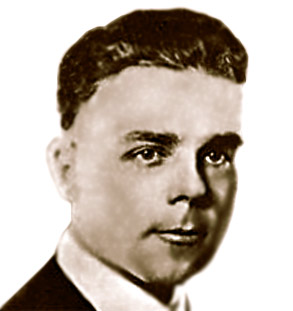
Abner Doble
It seems that young Abner and his brother John had an interest in
engineering from an early age bought on by their father's involvement in
the Abner Doble Company. Their interest in steam cars came from the
family owning a 1906 White steamer.
Abner Doble graduated from high school in California and went to
college at Massachusetts Institute of Technology in Cambridge, Mass. In
1910 he dropped out after less than a year of studies, and, with his
brother, began to design his own steam car. By 1912 they had built their
first car in Waltham, Mass. The car was apparently based on an American
Underslung chassis, their own engine and a Stanley Steamer boiler.
In view of Waltham's proximity to the Stanley works, the Watertown
Stanley factory was practically across the river from MIT and Waltham,
Abner attempted to interest the Stanley Twins in his development of the
condensing boiler. However, according to an oral history interview with
Raymond Stanley (F.E. Stanley's son), F.E. Stanley would not hire Abner
Doble because he didn't trust him. (Later accounts of Doble seem to
support this. Although recognized as a steam genius, Doble was
considered extremely arrogant and conceited, and was once arrested,
charged and convicted of mail fraud and stock manipulation in
California. It seems however that the conviction was overturned by
another court on appeal, so he never actually served time.)
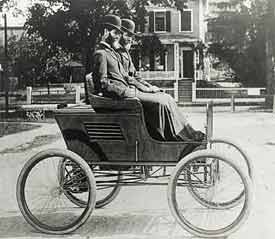
Stanley Brothers in an early Stanley Steamer
So, because Abner could not interest the Stanley Twins in his ideas,
Abner and his brother John decided to form their own company in 1914 in
Waltham, with apparent financial backing from their father. The fist car
that the Abner Doble Motor Vehicle Co. made, was the Model A. Records on
the number of cars of this model actually manufactured seems to differ
but possibly up to five cars were made. Four were sold and one was kept for
further development. The products were of good quality and appeared to
have a potentially good market. To develop the company and the product
further, it would be necessary to obtain further external finance. This
Abner secured this by going to Detroit in 1916 and joining up with C. L.
Lewis to form the General Engineering Co.
The new company had ambitious plans and developed a new simpler car
with potentially a mass market. It seems that there had been a good
response to the new 'Doble Detroit' and that there was a potential for
initial series production of some 11,000 cars. Unfortunately for the
partners, there was a war on in Europe and the US Government refused to
sanction the large quantity of steel that would have been required to
produce this number of cars. In view of this they only made some 30 cars
(some say 80), - and the project had "run out of steam" by
1918.
After the war Abner moved to California, to Emeryville near San
Francisco. He and his brothers formed in 1920 a new automobile
manufacturing company called "The Doble Steam Motors
Corporation" and commenced the development of the Model E. The
following year his brother John, now only 28, died of cancer. Abner was
devastated but continued with the development and eventually produced
what is considered to be amongst the best steamers ever made. It was a
large, expensive and sophisticated motorcar incorporating many new
features which made it very comparable to a petrol driven car. Gone was
major drawback to steam, the long waits for the boiler to heat up. The
Doble E was up and ready to go in one and a half minutes after turning
the switch. The car was fitted with a flash boiler feeding a horizontal
4-cylinder engine rated at some 75bhp, and the steam was recovered by a
really efficient condenser which gave a range of up to 1,500 miles on 24
gallons of water. Not only was there no trace of steam around the car, a
trademark of steamers, but there was hardly any noise.
The car was introduced to the public at the at the San Francisco Auto
Show in 1923 and was to be available in a variety of exotic coachwork
bodies made by Walter Murphy of Pasadena. The car was designed to be
luxurious and elegant and with a price tag to match, some $8,000. The
car was sold with an extensive guarantee; some say it had a three year
guarantee and others that it was guaranteed for 100,000 miles. Either
way, a Doble was a car of very obvious quality.
An aside to the history of Doble is that the famous Mr Howard Hughes
while in Houston, had become fascinated with steam cars and had
purchased a Doble and a Stanley. He was renowned for liking to drag race
on the streets of Houston, generally involving a wager which he
frequently won because a steamer had as much power from a standing start
as it did at full speed. Hughes therefore decided in 1926 to develop his
own steam car, the Hughes Steamer. The car was to be constructed by two
Caltech graduates, who successfully made the first car. They had
cleverly used the body as the condenser. Hughes withdrew from the
project when he realised that occupants would be boiled like lobsters if
the car was ever involved in an accident.
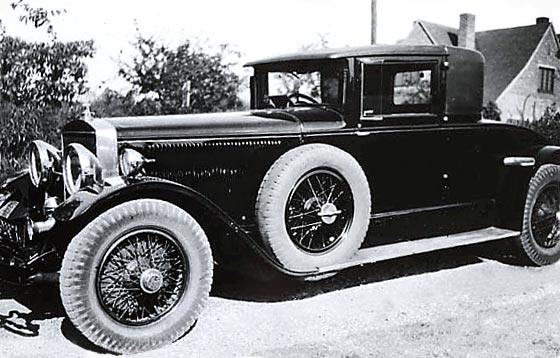
Abner Doble's E-24 Coupe as used by Abner Doble in
the UK in approx 1934.
Although everything was going well for the Doble Model E, it seems
not much was going well for Abner Doble. Plans were afoot to introduce
series production at some 300 cars a year and land was purchased around
the factory to extend the buildings to accommodate production of some
1,000 cars a year. These were to include a series of more economically
priced cars, the Doble Simplex. Unfortunately because of the way Abner
Doble had financially structured the company, it resulted in him being
extensively swindled on the stock market and landing up with a massive
debts. All the plans therefore came to nothing and the factory had to be
sold. He did however keep his own development Model E.
The Doble Car story therefore ends with the Model E after some 42
cars had been manufactured. The company was closed down in 1931. Some
sources say that, including all companies, about 125 Doble cars had been
made in total. Abner Doble did not attempt to start any new venture but
went on to become a steam power consultant to many of the companies
still involved in manufacture of steam vehicles.
In 1931 Abner Doble received a commission to travel to New Zealand to
assist in development of steam busses for A.G. Price Bus Company. In
1932 he came to England where he was engaged as a consultant by the
Sentinel Wagon Company working on steam lorries and locomotives.
He had brought with him to England his own Doble Model E, - and this
is where the 'Seend photograph' comes into the story. The car in the
photo carries the registration of UX 9826, UX being for the registration
issued by the County Council of Shropshire in Shrewsbury. The Sentinel
Wagon Works Ltd was based in Shrewsbury. The registration was issued in
1932.
This car has a fairly complete history. The car is a Doble E-24 Coupe
and was completed in June 1925, the last E Series Doble produced. It was
Abner Doble's personal car. Doble took the car to New Zealand and then
brought it to England when at Sentinel. He used the car to test
experimental equipment (new steam generator, burner, throttle, etc.),
and added more than 80,000 miles to it. In 1936, just before he left
England to go back to the US, Doble sold the car in London's Hyde Park
to a Mortimer Harmon Lewis.
Abner Doble then returned to California. He died on July 17, 1961, of
a heart attack, in Santa Rosa, California.
Lewis, the second owner of the Doble E-24 Coupe, added a rear seat by
cutting out a section of the body behind the front seat, and adding a
rear section to cover the added seat. This was Lewis's only car at the
time, and he had two young sons, so he had to adapt the coupe to fit.
The rear section was apparently part of a Swallow SS.
Lewis sold the car to a Mr. Elliott, who sold it to a Mr. D.C. Potter
in 1952. Potter sold the car to the McCulloch Co. in the US. The car was
used by them for testing and design work which resulted in one test of
breaking the crankshaft. The car was purchased from McCulloch Co. by
Richard Hemple who sold it to Harrah's Automobile Collection where it
underwent a full restoration. From Harrah's it was sold to Gen. Lyons,
who sold it to William Schutz, who sold it to its current owner, Mr.
Stan Lucas of Long Beach, California.
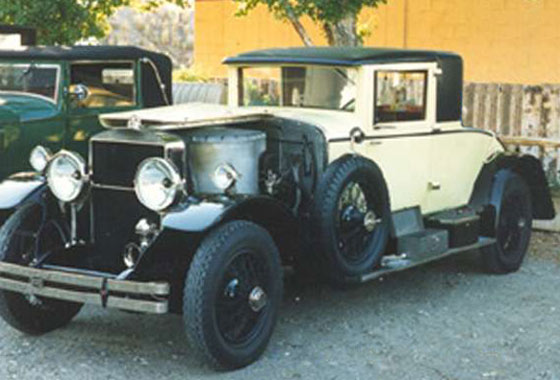
Abner Doble's E-24 Coupe refurbished and as it is
today in Long Beach California.
So, returning to the 'Seend photograph', in view that the name of Dr
Michael Earle Grandfather, Maurice Stafford Earle, is not mentioned in
the above list of owners, it is probable that the car never belonged to
his Grandfather. It may have come into his family album as a photograph
of a very interesting car belonging to a guest staying at the Seend
Guest House, which belonged to his Grandmother, Edith Mary Earle. Quite
who the guest was, whether Abner Doble, or one of the subsequent owners,
is interesting to speculate. Michael's father recalls that it the Doble
was very quiet.
So having established that the 'Seend photograph' was not the
Rolls-Royce owned by his Grandfather, Michael went back to his father,
now in his mid eighties, who went back into his attic and after much
rummaging around found three more photos. These did indeed include the
'Stafford Roller'. He thought it was a 1924 model bought second-hand for
£100 in 1938-39. The Rolls Royce was registered in Portsmouth. In the
photo it is being chauffeured by Ronald Phillips, son of his
grandmother's sister, who worked for his grandfather. The other photo is
of a mid 1920's Maxwell pictured outside the garage. In the background
the third floor of the Seend Guest House was being added. The last photo
is of a mid 20's Model T Landaulette which turns out to be the car that
his grandfather picked up at the factory and had 6d left over.
Presumably therefore the Model T was made in the UK.
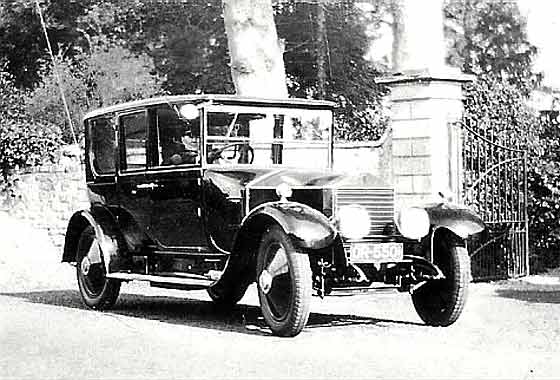

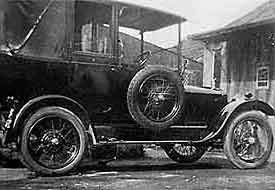
Copyright © MMVI, Bozi Mohacek. Reproduction only
by permission from the Author.
All photographs are strictly Copyright © by their owners.
Return to
Home Page
|